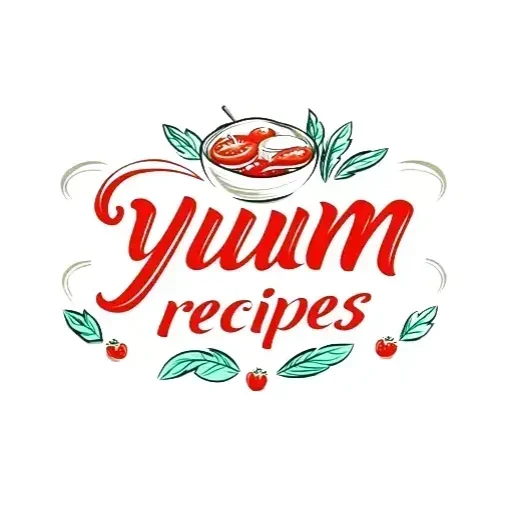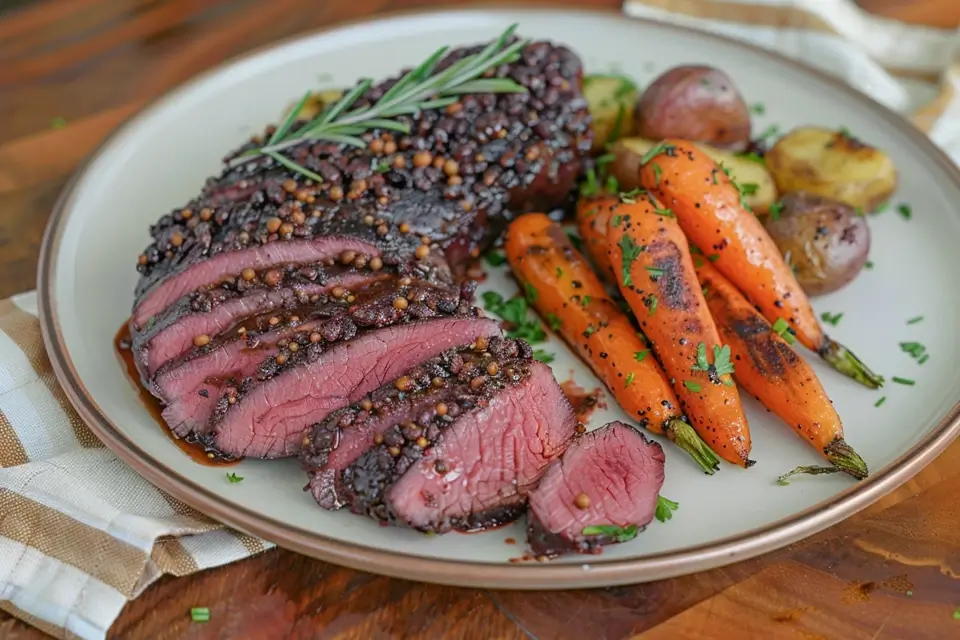Venison is a lean, flavorful meat loved by hunters and food enthusiasts alike. Cooking a venison roast might seem intimidating, but with the right technique, you can achieve a tender, juicy, and mouthwatering dish. This guide will walk you through everything you need to know, from choosing the best cut to cooking it perfectly and serving it with delicious sides.
We’ll explore slow cooking, oven roasting, and braising methods to help you find the best way to cook your venison roast recipe. Plus, you’ll get step-by-step instructions, cooking tips, and a nutrition facts table.
Table of contents
- Introduction to Venison Roast
- Choosing the Best Cut for Venison Roast
- Preparing Venison for the Best Flavor
- How to Cook Venison So It’s Tender
- Step-by-Step Venison Roast Recipe
- Best Side Dishes for Venison Roast
- Cooking Tips and Common Mistakes to Avoid
- Frequently Asked Questions (FAQs)
- Final Thoughts and Recipe Variations
- Conclusion
Introduction to Venison Roast
Venison isn’t just another type of red meat, it’s leaner, healthier, and packed with rich flavors. Whether you’re cooking it for a family dinner or a special occasion, understanding the basics is key to making it delicious.
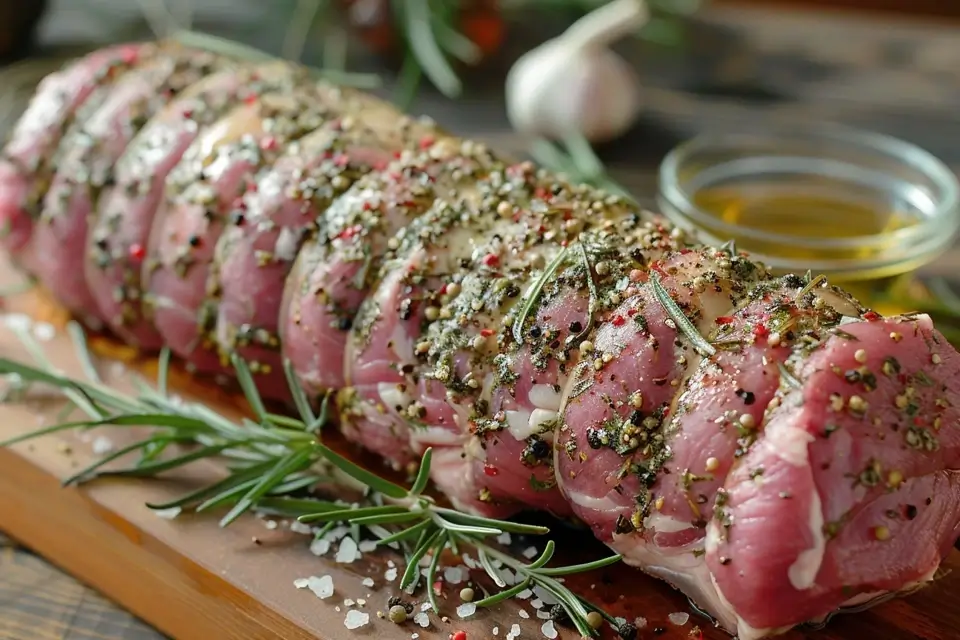
“A raw venison roast seasoned with rosemary and garlic, ready to be slow-cooked to perfection.”
What Is Venison?
Venison refers to deer meat, which is naturally low in fat and high in protein. Unlike beef, venison has a slightly earthy, gamey taste that pairs well with bold seasonings and slow cooking methods.
“Venison is often considered a delicacy because of its deep, rich flavor and tender texture when cooked properly.”
Why Cook Venison Roast?
Many people love venison for its natural, wild taste and nutritional benefits. Here’s why you should try making a venison roast recipe:
Healthier Choice – It contains less fat and fewer calories than beef.
Sustainable Meat – Many hunters prefer venison because it’s natural and free-range.
Rich in Nutrients – It’s packed with iron, B vitamins, and protein, making it a great option for a balanced diet.
Health Benefits of Venison Meat
Venison isn’t just delicious, it’s also super nutritious! Here’s a quick look at the health benefits:
| Nutrient | Amount per 100g | Benefit |
|---|---|---|
| Calories | 158 kcal | Low-calorie protein source |
| Protein | 30g | Supports muscle growth |
| Fat | 3g | Less fat than beef |
| Iron | 4mg | Boosts energy levels |
| Vitamin B12 | 2.6 mcg | Supports brain health |
“Venison is a great alternative to beef if you’re looking for a lean, high-protein meal with excellent nutritional value.”
With all these benefits, it’s no wonder that more people are choosing venison for their Sunday roasts and special occasions.
Choosing the Best Cut for Venison Roast
Selecting the right cut is crucial for a tender, flavorful venison roast recipe. Since venison is naturally leaner than beef, using the right cut and cooking method can make all the difference.
What Is the Best Cut of Venison for Roasting?
Not all venison cuts are created equal. The best cuts for a juicy, tender roast include:
Backstrap (Loin): Super tender and lean, best for quick roasting.
Hindquarter (Rump or Round): Lean with great flavor perfect for slow roasting.
Shoulder (Chuck Roast): Tougher but flavorful, best for slow cooking or braising.
Neck Roast: Requires low and slow cooking to break down connective tissue.
“For a classic oven-roasted venison dish, the hindquarter or backstrap is your best bet. If you’re using a slow cooker, the shoulder or neck will give you a melt-in-your-mouth texture.”
Bone-In vs. Boneless: Which One to Choose?
Both options have their perks:
- Bone-In: Adds extra flavor and moisture while cooking. Best for slow roasting.
- Boneless: Easier to slice and serve. Ideal for oven roasting or braising.
If you’re unsure, go for a bone-in venison roast for added depth of flavor!
Fresh vs. Frozen Venison: Does It Matter?
Fresh venison is always best, but frozen venison works just as well if thawed properly. To ensure optimal taste and texture:
Thaw in the refrigerator for 24-48 hours (never at room temp!).
Pat dry to remove excess moisture before seasoning.
Avoid refreezing once thawed, as it can alter the texture.
Now that you’ve chosen the perfect cut, let’s move on to preparing venison for maximum flavor!
Preparing Venison for the Best Flavor
Before you start cooking your venison roast recipe, it’s important to prepare the meat properly. This helps remove any gamey taste while enhancing tenderness and flavor.
How to Properly Thaw Venison Roast
If you’re working with frozen venison, follow these steps to keep the meat juicy and tender:
Refrigerate for 24-48 hours – The safest way to thaw venison.
Use cold water (if in a hurry) – Submerge the vacuum-sealed meat in cold water for 1-2 hours.
Pat dry – Use paper towels to remove excess moisture before seasoning.
“Never thaw venison in warm water or at room temperature, it can lead to uneven cooking and bacteria growth.”
The Best Marinades for Venison Roast
Because venison is lean, marinating it helps break down the muscle fibers for a softer texture. Try these flavorful marinades:
- Red Wine & Garlic Marinade – Adds richness and depth.
- Balsamic & Rosemary Marinade – Enhances natural flavors with a touch of sweetness.
- Buttermilk Soak – Helps neutralize any gamey taste.
Here’s a simple marinade to try:
Red Wine Marinade Recipe:
- 1 cup red wine
- ¼ cup olive oil
- 3 garlic cloves, minced
- 2 tbsp Worcestershire sauce
- 1 tsp black pepper
- 1 tsp salt
- 1 tbsp fresh rosemary
Mix everything in a bowl, pour over the venison, and marinate for 4-8 hours in the fridge.
Seasoning Tips for Maximum Flavor
Venison has a bold taste, so it pairs well with earthy, aromatic seasonings. Here are some must-have spices:
Garlic & Onion Powder – Adds depth of flavor.
Rosemary & Thyme – Classic herbs for roasting.
Smoked Paprika & Black Pepper – Gives a warm, smoky touch.
“Avoid using too much salt before cooking, it can draw out moisture and make the roast dry.”
Final Prep Steps Before Cooking
Before placing your venison roast in the oven or slow cooker:
Bring it to room temperature for even cooking.
Sear the outside for a rich, caramelized crust.
Use a meat thermometer to prevent overcooking.
There were no relevant internal links on yuumrecipes.com related to venison roast recipe. However, if you’re looking for more delicious recipes, check out other wild game dishes or slow cooker meals on their website!
Now, let’s continue writing Part 4 and Part 5 of the article.
How to Cook Venison So It’s Tender
Cooking venison the right way makes all the difference. Since venison is leaner than beef, it can easily become tough and dry if overcooked. But don’t worry! Below, we’ll go through the best cooking methods to ensure your venison roast recipe is tender, juicy, and packed with flavor.
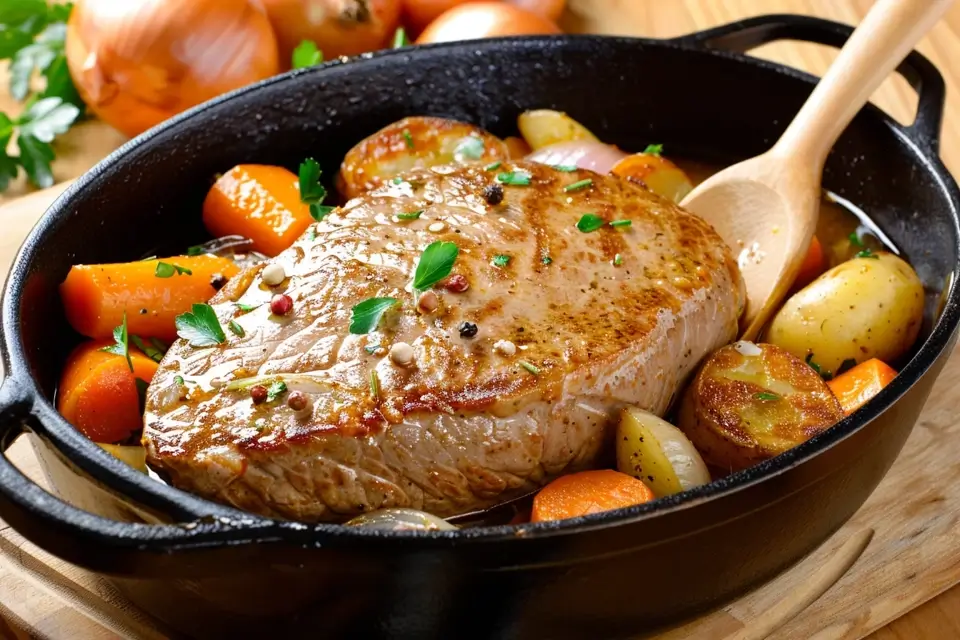
“Venison roast braising in a Dutch oven with broth, vegetables, and seasonings for the perfect melt-in-your-mouth texture.”
Slow Cooker Method: The Set-It-and-Forget-It Approach
If you want fall-apart tender venison, slow cooking is the way to go. The low and slow heat helps break down the meat’s fibers, making it incredibly juicy.
How to Cook Venison Roast in a Slow Cooker:
Sear the meat first – This locks in flavor and gives a nice crust.
Add aromatics – Use onions, garlic, and fresh herbs for extra depth.
Pour in broth or wine – This keeps the meat moist. Use beef broth, red wine, or a mix.
Cook on LOW for 8-10 hours – The longer, the better!
Let it rest before slicing – This keeps the juices inside.
“Cooking venison roast in a slow cooker makes it tender and full of flavor with minimal effort.”
Oven Roasting: Perfect for a Crispy, Flavorful Finish
If you love a crispy crust with a tender inside, oven roasting is the best method.
How to Roast Venison in the Oven:
Preheat the oven to 275°F (135°C).
Sear the roast in a hot pan (2-3 minutes per side).
Place the venison in a roasting pan with carrots, onions, and potatoes.
Pour in beef broth and cover with foil.
Roast for 2-3 hours or until the internal temp reaches 130°F (medium-rare).
“For a Jamie Oliver-style venison roast, add a red wine reduction and fresh rosemary for extra richness.”
Braised Venison Roast: Cooking Low and Slow for Maximum Tenderness
Braised venison is slow-cooked in liquid, making it fork-tender and full of deep, rich flavors.
How to Braise Venison:
Sear the venison roast on all sides.
Place it in a Dutch oven with garlic, onions, and root vegetables.
Pour in red wine, beef broth, or tomato sauce.
Cover and cook at 300°F (150°C) for 3-4 hours.
Let it rest before slicing for the best texture.
“Braising venison roast is the secret to a flavorful, tender meal that melts in your mouth.”
Now that you know how to cook venison for ultimate tenderness, let’s move on to the full step-by-step recipe!
Cooking venison correctly makes all the difference. If you enjoy slow-cooked meats, you might also love our Poor Man’s Prime Rib Recipe, which uses similar low and slow cooking techniques to achieve the perfect tenderness
Step-by-Step Venison Roast Recipe
Now, let’s put everything together with a simple, foolproof venison roast recipe that works for oven roasting, slow cooking, or braising.
Ingredients You’ll Need
Here’s what you need for a perfect venison roast:
| Ingredient | Quantity |
|---|---|
| Venison Roast | 3-4 lbs |
| Olive Oil | 2 tbsp |
| Garlic Cloves | 4, minced |
| Onion | 1 large, sliced |
| Carrots | 3, chopped |
| Potatoes | 3, quartered |
| Beef Broth | 2 cups |
| Red Wine | 1 cup |
| Worcestershire Sauce | 2 tbsp |
| Fresh Rosemary & Thyme | 2 sprigs each |
| Salt & Black Pepper | To taste |
“The key to a delicious venison roast is using fresh herbs, broth, and a touch of wine to keep the meat moist and flavorful.”
Preparation: Prepping Your Roast for Success
Thaw the venison roast in the fridge overnight if frozen.
Pat dry to remove excess moisture.
Rub with salt, pepper, and olive oil.
Sear the roast in a hot skillet for a deep brown crust.
Cooking Instructions: Bringing Out the Best in Your Venison
For Slow Cooker:
- Place venison, veggies, and broth in the crockpot.
- Cook on LOW for 8-10 hours.
- Shred or slice before serving.
For Oven Roasting:
- Roast at 275°F (135°C) for 2-3 hours, basting occasionally.
- Rest for 10 minutes before slicing.
For Braising:
- Simmer in a Dutch oven at 300°F (150°C) for 3-4 hours.
- Serve with pan sauce.
“No matter which method you choose, your venison roast will be juicy, tender, and packed with flavor!”
Looking for more savory and comforting meals? Try our Smoked Salmon Salad for a light and refreshing side dish to balance the richness of this venison roast recipe.
Best Side Dishes for Venison Roast
A great meal isn’t just about the main dish, the side dishes can take it to the next level. Since venison has a rich, earthy flavor, it pairs well with hearty, savory, and slightly sweet sides.
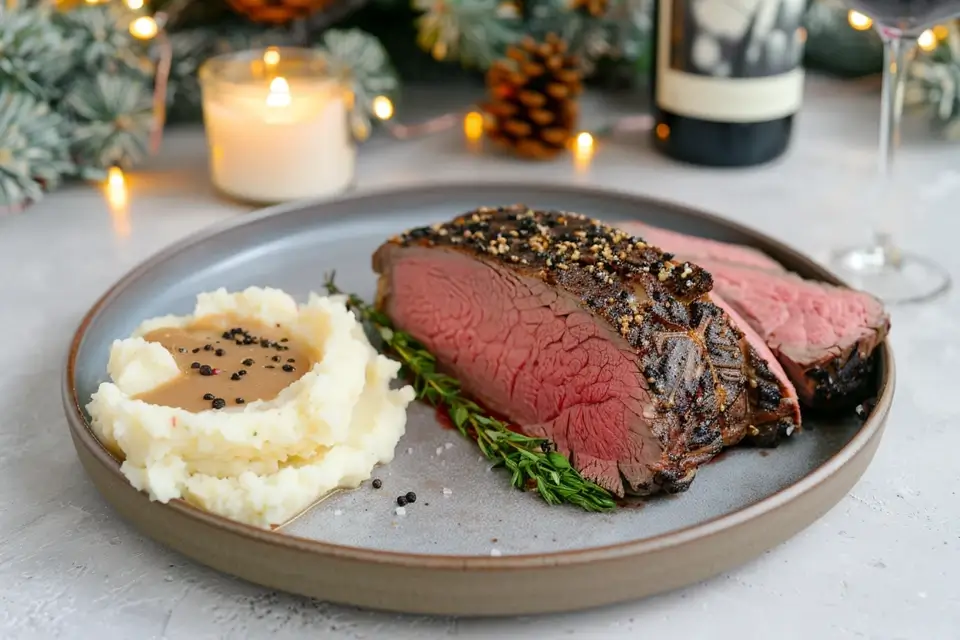
“A beautifully plated venison roast with creamy mashed potatoes, homemade gravy, and a side of roasted vegetables.”
Classic Pairings: Potatoes, Carrots, and More
Roasted Garlic Mashed Potatoes – Creamy, buttery potatoes balance venison’s bold taste.
Honey-Glazed Carrots – Adds a touch of sweetness to contrast the savory meat.
Oven-Roasted Brussels Sprouts – Crispy, flavorful, and a perfect side for any roast.
Buttery Dinner Rolls – Great for soaking up the delicious juices from the roast.
“A classic venison roast recipe with mashed potatoes and roasted veggies makes for a comforting, restaurant-quality meal at home.”
Creative Side Dishes to Elevate Your Meal
Looking to mix things up? Try these unique, flavorful sides:
Wild Rice Pilaf – Nutty and slightly chewy, wild rice complements venison beautifully.
Maple-Glazed Sweet Potatoes – A perfect blend of sweet and savory.
Cranberry Sauce with Orange Zest – A bright, tart contrast to venison’s richness.
Parmesan Roasted Asparagus – Adds a crispy, salty crunch to your plate.
Sauces and Gravies: Enhancing the Flavor of Venison
The right sauce can turn a good venison roast into an unforgettable meal!
Red Wine Reduction – Bold and rich, perfect for oven-roasted venison.
Classic Venison Gravy – Made from pan drippings, broth, and butter.
Cranberry Balsamic Sauce – A sweet-tangy sauce that pairs well with game meat.
“Don’t skip the sauce! A simple red wine glaze or a rich venison gravy can make all the difference.”
Now that you know what to serve with your venison roast recipe, let’s go over cooking tips and common mistakes to avoid.
For the perfect pairing, serve this venison roast with warm, buttery bread or a side of hearty potatoes. If you love classic comfort food, check out our Ultimate Guide to Butter Salmon, a dish that also pairs beautifully with roasted vegetables and mashed potatoes.
Cooking Tips and Common Mistakes to Avoid
Even experienced cooks sometimes struggle with venison. Since it’s leaner than beef, it requires extra care to keep it tender and juicy. Here are some expert tips and common mistakes to watch out for.
Why Venison Can Be Tough and How to Fix It
Venison lacks marbling (fat inside the meat), which means it can dry out quickly. Here’s how to keep it tender:
Use low temperatures – Slow cooking or roasting at 275°F (135°C) helps prevent toughness.
Always let it rest – Resting the roast for at least 10 minutes keeps the juices inside.
Don’t overcook – The best internal temperature is 130-140°F (medium-rare to medium).
Marinate for extra tenderness – Acidic marinades break down fibers and add moisture.
“Venison is easy to overcook! A meat thermometer is your best friend when cooking this lean meat.”
The Best Cooking Temperatures for Venison Roast
Cooking temperature is key to getting a perfect venison roast recipe. Here’s a quick guide:
| Doneness | Internal Temperature |
|---|---|
| Rare | 120-125°F (49-52°C) |
| Medium-Rare | 130-135°F (54-57°C) |
| Medium | 140-145°F (60-63°C) |
| Well-Done | 150°F+ (65°C+) |
“For the best texture, aim for medium-rare (130-135°F) and let the roast rest before slicing.”
Resting and Slicing: The Final Steps for Perfection
Let it rest for 10-15 minutes before cutting to keep it juicy.
Slice against the grain for maximum tenderness.
Serve with gravy or sauce to enhance the natural flavors.
“Slicing venison correctly makes a huge difference! Cutting against the grain shortens the muscle fibers, making each bite more tender.”
If you’re a fan of tender, slow-cooked meats, you might enjoy our How to Cook Poor Man’s Prime Rib. It follows a similar low-temperature roasting method for an ultra-juicy finish, just like this venison roast recipe.
Frequently Asked Questions (FAQs)
Here are some of the most commonly asked questions about making the perfect venison roast recipe.
1. How do you cook venison so it’s tender?
Venison is lean, so it needs special care to keep it moist and tender. Follow these key steps:
Use slow cooking – Cooking at a low temperature breaks down fibers for extra tenderness.
Marinate for at least 4 hours – Acids like vinegar or red wine help soften the meat.
Avoid overcooking – Medium-rare (130-135°F) is the best for juicy venison.
Let it rest – Always let your roast sit for 10-15 minutes before slicing.
“The secret to a juicy venison roast is patience, low heat, slow cooking, and a good marinade.”
2. How long does it take to roast venison?
The cooking time depends on the size of the roast and the method used:
| Cooking Method | Temperature | Cooking Time |
|---|---|---|
| Slow Cooker | LOW | 8-10 hours |
| Oven Roasting | 275°F (135°C) | 2-3 hours |
| Braising | 300°F (150°C) | 3-4 hours |
Always use a meat thermometer to check for doneness. Medium-rare (130-135°F) is ideal for a tender roast.
3. How do you roast venison in the oven like Jamie Oliver?
Jamie Oliver’s venison recipes often focus on simple, rustic flavors. Here’s a quick guide to a classic oven-roasted venison:
Preheat oven to 275°F (135°C).
Season the roast with olive oil, garlic, rosemary, salt, and pepper.
Sear the meat in a hot pan to lock in juices.
Place in a roasting dish with carrots, onions, and broth.
Roast for 2-3 hours until the internal temp is 130°F (medium-rare).
“Jamie Oliver-style venison is all about fresh herbs, slow roasting, and simple seasonings that highlight the natural flavors.”
4. What is the best cut of venison for a roast?
The best cuts for a venison roast recipe are:
Backstrap (Loin): Super tender, great for quick roasting.
Hindquarter (Rump or Round): Lean and flavorful, perfect for slow cooking.
Shoulder (Chuck Roast): Tougher but amazing for braising.
Neck Roast: Great for long, slow-cooked meals like stews.
“For an easy and flavorful roast, choose a hindquarter cut and cook it low and slow.”
Now that we’ve answered the most common questions, let’s explore variations of this recipe to keep things interesting!
If you’re looking for more ways to enjoy flavorful meats, don’t miss our Beef Chorizo Recipes, which include delicious ideas for making spicy, protein-packed meals with bold seasonings.
Final Thoughts and Recipe Variations
Once you’ve mastered the classic venison roast, why not try something new? Here are some delicious ways to switch it up!
Experimenting with Different Flavors and Cooking Styles
Red Wine & Garlic Roast – Marinate the meat in red wine, garlic, and rosemary for a richer taste.
Smoked Venison Roast – Use a smoker at 225°F for a deep, smoky flavor.
Apple Cider Glazed Venison – Roast with a glaze of apple cider and maple syrup for a sweet twist.
Venison Pot Roast – Add potatoes, carrots, and broth for a one-pot comfort meal.
“Cooking venison is all about playing with flavors, don’t be afraid to experiment!”
Venison Roast for Special Occasions
The venison roast isn’t just for everyday meals, it’s perfect for special occasions like:
Christmas Dinner – Serve with cranberry sauce and roasted chestnuts.
Thanksgiving Feast – A delicious alternative to turkey!
Outdoor BBQ Night – Try a grilled venison roast with smoky BBQ sauce.
“Venison roast is elegant, delicious, and guaranteed to impress your guests.”
Final Tips for a Perfect Venison Roast Every Time
Use a thermometer – Never guess the temperature! Medium-rare is 130-135°F.
Rest the meat before slicing – This keeps it juicy.
Try different herbs and spices – Rosemary, thyme, and smoked paprika work great!
Pair with the right sides – Roasted potatoes, wild rice, and gravy complete the meal.
Conclusion
Cooking a venison roast recipe may seem tricky at first, but with the right techniques and a little patience, you’ll end up with a tender, juicy, and flavorful dish. Whether you slow cook, roast, or braise, the key is to cook it low and slow, use simple seasonings, and pair it with great sides.
Venison is a healthy, lean, and sustainable meat that makes for a delicious family meal or a special occasion dish. Now that you know everything about choosing, preparing, and cooking venison, it’s time to try it yourself!
So, grab your ingredients, follow these tips, and enjoy the best venison roast you’ve ever had!
If you’re interested in more hearty, flavorful dishes, check out our Poor Man’s Prime Rib Guide or explore our Dinner Recipes for more inspiration!
